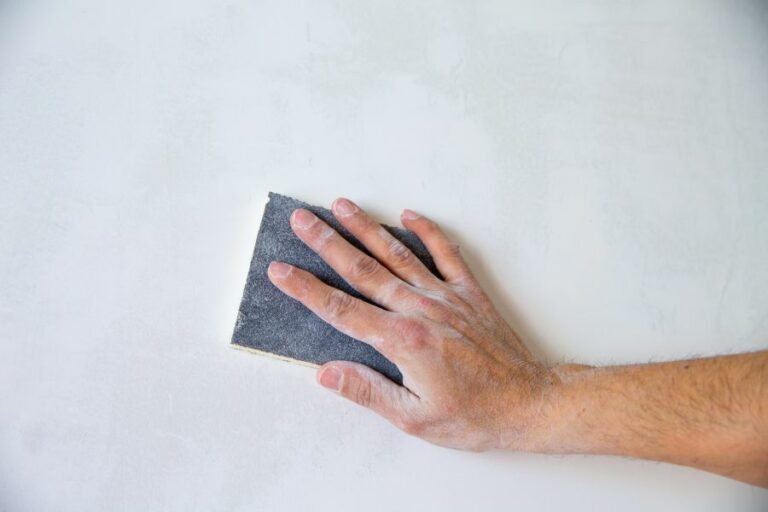Sanding Hacks For Flawless Painting, 25 Things You Should Know
Are you tired of unsatisfactory paint jobs that leave you frustrated and feeling like you’ve wasted time? You’re not alone! A flawless paint finish starts with proper sanding techniques. Lucky for you, we’ve got some fantastic sanding hacks to make your next painting project a breeze. In just a few simple steps, you’ll achieve a smooth and professional-looking result that will make you proud.
Sanding hacks for flawless painting:
To achieve a flawless paint job, use proper sanding techniques such as choosing the right sandpaper grit, utilizing a sanding block or electric sander, sanding with the grain on wooden surfaces, maintaining a clean work area, applying appropriate pressure, sanding between paint coats, wet sanding for ultra-smooth finishes, and following safety measures.

Ready to achieve a flawless paint job? We’ve got some top-secret sanding hacks in store for you that will turn your paint projects into stunning masterpieces. Keep reading to uncover these expert tips and make your painted surfaces look smoother than ever before!
Contents
- 1 Expert Sanding Techniques for Perfect Paintwork
- 2 Achieving Smooth Finishes: Sanding Paint Tips
- 3 Top Sandpaper Choices for Sleek Paint Surfaces
- 4 Smoothing Out Rough Paint: Sanding Solutions
- 5 Sanding Tips for Balancing Uneven Paint Surfaces
Expert Sanding Techniques for Perfect Paintwork
Painting your walls, furniture, or other surfaces can significantly improve their appearance. However, the key to achieving a professional, flawless finish lies in the preparation stage, particularly in the sanding process.
• Understand the Importance of Sanding
Sanding is essential for three primary reasons: to remove existing paint or finish, to smooth out imperfections on the surface, and to create better adhesion for the new paint. To achieve a smooth, professional painting result, thorough sanding is crucial.
– Choose the Right Sandpaper
Selecting the appropriate sandpaper for your project plays a significant role in the end results. Sandpapers come in various grits ranging from coarse (40-60 grit) to very fine (220-400 grit). Choosing the right grit depends on the surface you’re working on, your project’s objective, and the paint you’ll use.
For example, if you need to remove old paint or varnish, it’s best to start with coarse-grit sandpaper. Conversely, if you aim to achieve a smooth finish, opt for a fine or very fine-grit paper. If you’re unsure, consult a professional or refer to expert sources, such as the Paint Quality Institute.
– Use a Sanding Block or Electric Sander
To ensure even and consistent sanding, always use a sanding block or an electric sander. A sanding block is a simple tool that allows you to wrap the sandpaper around it, maintaining a flat surface while you sand.
Alternatively, electric hand sanders provide more power and efficiency, significantly speeding up the process. When choosing an electric sander, consider the following types:
- Orbital sanders: Ideal for light sanding tasks, such as scuff-sanding between paint coats.
- Random orbital sanders: Suitable for heavier tasks, such as removing old paint or smoothing rough surfaces.
– Sand in the Same Direction as the Grain
When sanding wooden surfaces, always sand in the direction of the wood grain. This prevents scratches and ensures a smooth finish. When working on furniture, moldings, or natural wood surfaces, please pay close attention to the grain direction and make it a habit to sand.
– Keep the Surface Clean
Keeping your work area clean is essential for achieving professional results. After sanding, thoroughly clean the surface using a vacuum, tack cloth, or damp cloth (for water-based paints). Removing dust particles ensures better adhesion and prevents imperfections in the final paint job.
– Adjust Your Pressure
Applying the right amount of pressure when sanding is crucial for optimal results. Too much pressure can cause grooves and uneven surfaces, while too little pressure may leave the surface poorly prepared.
A good rule of thumb is to apply light to moderate pressure – allowing the sandpaper or sander to do the work for you.
– Sand Between Coats
To achieve a professional, smooth finish, it’s vital to sand between paint coats. Once the first coat has dried, lightly sand the surface with fine or very fine grit sandpaper to ensure proper adhesion of the next coat. This also helps eliminate brush strokes, roller marks, and other imperfections.
• Embrace Wet Sanding
For surfaces that require a super smooth finish, such as glossy or semi-gloss paint, wet sanding comes in handy. Wet sanding involves using a combination of water and fine-grit sandpaper to create an ultra-smooth surface. This technique is particularly useful for automotive paint jobs, furniture, and cabinetry.
• Practice Safety Measures
When sanding surfaces, it’s essential to prioritize safety. Wear appropriate protective gear, such as safety goggles, gloves, and a dust mask or respirator, to protect your eyes, hands, and lungs from dust and debris.
• Final Thoughts
Remember, the key to a flawless paint job lies in the preparation stage, specifically in thorough sanding. By following these sanding hacks and adjusting them to suit your specific project, you’ll achieve a professional, smooth, and lasting finish.
Achieving Smooth Finishes: Sanding Paint Tips
A smooth, polished finish is the ultimate goal for expert painters and DIY enthusiasts alike. Sanding paint is a crucial step in achieving this immaculate result.
• The Importance of Sanding Paint
Sanding paint serves a dual purpose: it removes imperfections in the paint and creates a smooth canvas for subsequent finishes. By doing so, it ensures a professional, flawless result that lasts. Additionally, sanding enhances paint adhesion, which minimizes the possibility of peeling or flaking over time.
• Choosing the Right Sandpaper
Selecting the best sandpaper for your project is essential to achieving smooth results. The following factors should be considered:
– Grit
Sandpaper grit refers to the roughness or coarseness of the abrasive particles. The more coarse a sandpaper, the higher its grit number. Choosing the right grit depends on the type of paint and the desired finish.
Generally, a fine to medium grit paper (between 120 and 220) is ideal for sanding paint. You may also need to start with a coarse grit (80-120) if dealing with rough or uneven surfaces before moving on to finer grits.
– Type of Sandpaper
There are three main types of sandpaper, each with its own benefits:
- Aluminum oxide: A durable and versatile option, suitable for sanding paint on wood, metal, and other materials.
- Silicon carbide: Often used for wet sanding, it works well on metal, plastic, and other hard surfaces.
- Garnet: A softer, more delicate option, ideal for hand-sanding and woodworking projects.
Choose a sandpaper best suited to your surface and material for optimal results.
• Tips for Effective Sanding: Technique and Tools
– Hand Sanding
Hand sanding using a sanding block is an effective method for small, intricate areas or delicate surfaces. It offers greater control and precision, allowing for a more refined result.
- Attach your sandpaper to a sanding block. This will provide a stable, flat surface for sanding.
- Sand the painted surface in a circular motion, applying even pressure.
- Continuously check for a smooth finish and adjust your technique accordingly.
– Power Sanders
Power sanders are perfect for larger projects or areas with thicker paint layers. They come in various types, such as orbital, random orbital, and belt sanders. We recommend using a random orbital sander for sanding paint, as it prevents swirl marks and can accommodate various grits.
- Attach the sanding disc with the appropriate grit to your sander.
- Power on the sander and gently apply it to the paint surface. Do not apply excessive pressure, as it may cause gouging or uneven results.
- Keep the sander moving in a consistent pattern to avoid over-sanding any area.
– Wet Sanding
Wet sanding is ideal for high-gloss finishes or when dealing with delicate surfaces, such as automotive paint. It reduces friction and dust, resulting in a smoother finish.
- Soak your silicon carbide sandpaper in water for a few minutes prior to sanding.
- Gently sand the paint while keeping the sandpaper and surface wet. A spray bottle can help maintain consistent moisture.
- Frequently wipe the surface with a clean, damp cloth to remove debris and prevent clogging.
• Final Steps to a Smooth Finish
Once you’ve sanded the paint to the desired smoothness, you can apply a primer, sealer, or additional coats of paint, depending on your project requirements.
• Safety Precautions While Sanding
When sanding paint, it’s essential to protect yourself from inhaling dust particles and debris. Wear a N95-rated dust mask and safety glasses during the sanding process. Additionally, ensure proper ventilation in your workspace to minimize dust inhalation.
In conclusion, sanding paint is an essential step toward achieving a smooth, professional finish on any painting project.
By selecting the appropriate sandpaper, employing the proper techniques and tools, and adhering to safety precautions, you can confidently transform your painted surfaces into flawless masterpiece.
Step | Description |
|---|---|
1 | Choose the correct sandpaper grit. Fine grits (220-340) are best for sanding painted surfaces. |
2 | Clean the surface using a damp cloth to remove dirt and dust. |
3 | Allow the surface to dry completely before sanding. |
4 | Wear a protective mask to avoid inhaling dust particles. |
5 | Hold the sandpaper against the surface and move it in a circular motion, applying even pressure. |
6 | Change the sandpaper as needed if it becomes worn or clogged with paint. |
7 | Wipe the surface with a damp cloth to remove sanding dust. |
8 | Inspect the surface for any remaining imperfections and repeat sanding if necessary. |
9 | Apply a new layer of paint, if desired, for a smooth and professional-looking finish. |
Top Sandpaper Choices for Sleek Paint Surfaces
When it comes to smoothing paint, choosing the right sandpaper is crucial for achieving a professional, flawless finish. With a plethora of sandpaper varieties, grits, and materials on the market, it is essential to understand which one is best suited for the task.
• The Importance of the Right Sandpaper Grit
Sandpaper is categorized according to its grit size and the number of abrasive particles per inch. The higher the grit number, the finer the sandpaper and the smoother the finish it will produce.
On the other hand, lower-grit sizes indicate coarser sandpaper, which is useful for removing material quickly but will leave a rougher finish.
– Initial Surface Preparation
When starting a paint job, it is critical to prepare the surface for painting by removing any previous paint layers, debris, or imperfections. Using coarse sandpaper (40 to 80 grit) is recommended for this stage, as it will efficiently strip the surface and create a suitable foundation for the new paint layer.
– Intermediate Sanding
After the initial preparation, the surface will likely require further smoothing before applying the paint. For this stage, medium-grit sandpaper (100 to 150 grit) is usually ideal. It will remove any remaining imperfections while also refining the surface for painting.
– Final Smoothing
Once the paint has been applied and allowed to dry, a final pass with fine sandpaper (180 to 240 grit) will achieve a smooth, professional finish. This step is especially vital when working with glossy paints or using a polishing compound to bring out the shine in your paint job.
• Choosing the Right Sandpaper Material
The material used to create sandpaper also plays a crucial role in determining its effectiveness for specific applications. There are several popular sandpaper materials available, each with its benefits and drawbacks:
– Aluminum Oxide
Aluminum oxide is a widespread synthetic material found in sandpapers. It is a durable and versatile choice that works well for smoothing paint, particularly for wood surfaces. This type of sandpaper is ideal for intermediate sanding and final smoothing, thanks to its long-lasting abrasive properties.
– Silicon Carbide
Commonly referred to as “wet or dry” sandpaper, silicon carbide sandpaper boasts a waterproof feature that allows it to be used in conjunction with water or lubricating oils.
This material is particularly suited for final smoothing, as the water or lubricant helps minimize the risk of the sandpaper scratching the paint surface.
– Garnet
Garnet is a natural abrasive made from crushed garnet stones. While not as durable as aluminum oxide or silicon carbide, garnet sandpaper offers excellent performance for smoothing wood surfaces in preparation for painting. However, it is not recommended for use on metal or synthetic surfaces.
• Tips for Selecting the Perfect Sandpaper
With numerous sandpapers available, it can be easy to get overwhelmed with your options. Here are some helpful tips to consider when choosing the best sandpaper for your paint-smoothing job:
- Know your surface: It is vital to understand the material you are working with, as wood and metal surfaces will require different sandpapers for optimal results.
- Evaluate the paint: The type of paint you are working with will determine the final sanding grit required. Glossy paints generally necessitate a higher-grit sandpaper for smooth finishes.
- Mind the grit progression: While working, make sure to progress through grit sizes sequentially. Skipping grits might leave visible scratches and hinder your overall finish.
- Consider the sandpaper’s backing: Flexible backings, such as cloth or foam, can better contour to uneven surfaces and access hard-to-reach areas.
• Conclusion
To achieve the best results when smoothing paint, a proper selection of sandpaper based on grit size, material, and backing is crucial.
Remember, the key to a smooth, professional paint job lies in a combination of correct surface preparation, the right sandpaper, and proper technique. With these tools and knowledge at your disposal, you are well on your way to achieving that coveted flawless finish.
Type | Grit | Usage |
|---|---|---|
Aluminum Oxide | 80-220 | General purpose sanding, good for paint removal and smoothing. |
Garnet | 150-220 | Ideal for hand-sanding and provides a smooth finish on wood surfaces. |
Silicon Carbide | 320-2000 | Used for wet-sanding and provides a smooth, even finish on paint and clear coats. |
Smoothing Out Rough Paint: Sanding Solutions
• Proper Preparation Is Key
Before you begin sanding bumpy paint, it is crucial to first prepare your workspace and gather the necessary tools.
First and foremost, ensure that the area is well-ventilated, as the sanding process can produce a significant amount of dust. If working indoors, open windows and set up fans to maximize airflow. It is also essential to protect yourself by wearing a dust mask and eye protection.
Finally, gather the following tools and materials: a drop cloth, sandpaper (or a sanding sponge), a sanding block or power sander, a clean cloth, a primer (optional), and the appropriate new paint.
• Choosing the Right Sanding Tools
When sanding bumpy paint, it is essential to select the appropriate tools for the job. The type of sanding tool you choose will depend on the size of the area to be sanded and the severity of the bumps.
For small areas or minor bumps, hand-sanding with a sanding block or a sanding sponge is often sufficient. For larger areas or more severe bumps, I recommend using a power sander such as an orbital or random orbit sander.
Both options have their benefits, with the orbital sander being more aggressive and the random orbit sander providing a more uniform finish.
Whichever option you choose, start with a coarse grit sandpaper (e.g., 60 or 80 grit) to remove the majority of the bumps and switch to finer grit (e.g., 150 or 220 grit) to achieve a smooth finish.
• The Sanding Process
Begin the sanding process by laying down a drop cloth to catch dust and debris. If using a power sander, plug it in and ensure that it’s in good working order. For hand-sanding, wrap the appropriate sandpaper around a sanding block or sponge.
Remember to always sand in the direction of the wood grain, as sanding against the grain can create scratches and an uneven surface.
– Step 1: Identify the Bumpy Areas
Before you start sanding, the first step is to visually inspect the painted surface and identify the bumpy areas. If necessary, mark them using a pencil or piece of masking tape to ensure you don’t miss any spots.
– Step 2: Begin Sanding
Once you have identified the problem areas, start sanding by applying gentle yet firm pressure to the bumpiest spots. Give it a quick wipe down with a clean cloth and then sand further if the surface is still not smooth.
– Step 3: Sand the Entire Surface
After you have addressed the problem areas, it is vital to sand the entire surface to ensure a uniform finish. If using a power sander, move the sander evenly across the surface in a controlled manner. For hand-sanding, use long, sweeping motions with a consistent amount of pressure.
– Step 4: Final Inspection and Touch-ups
After sanding the entire surface, inspect it once more for any remaining bumps or imperfections. Address these areas with additional sanding as needed.
Once you are satisfied with the smoothness, clean the surface thoroughly with a tack cloth or clean, damp cloth. This critical step helps to remove any lingering sanding dust before you proceed to the next stage.
• Priming and Repainting
Once the surface is smooth and dust-free, consider applying a high-quality primer to ensure proper paint adhesion. Although some paints come with primer mixed in, a separate primer is often a good idea, especially when covering bumpy paint.
The US Environmental Protection Agency recommends using a lead-free primer to protect your family from the harmful effects of lead exposure. Allow the primer to dry completely, following the manufacturer’s instructions for drying times, before applying the new coat of paint.
Be sure to apply the paint evenly and smoothly for the best possible results.
• Conclusion
Sanding bumpy paint can be a time-consuming and labor-intensive process. However, by following the steps outlined above and using the appropriate tools and techniques, you can restore your painted surfaces to a smooth and appealing finish.
Step | Description |
|---|---|
1 | Clean the surface with a damp cloth and allow it to dry completely. |
2 | Choose a suitable sandpaper grit, such as 120-150 grit, for minor irregularities or 80 grit for more pronounced bumpy spots. |
3 | Attach the sandpaper to a sanding block or pole sander for better control. |
4 | Sand the bumpy paint gently in a circular motion, applying even pressure until the surface is smooth and even. |
5 | Wipe the surface with a clean, damp cloth to remove any dust and debris from sanding. |
6 | Allow the surface to dry, and then apply a new coat of paint or primer, as desired. |
Sanding Tips for Balancing Uneven Paint Surfaces
Uneven paint on walls or furniture can be an eyesore and may even cause further problems down the line. Thankfully, sanding uneven paint is a straightforward process that can be easily completed with a little patience and the right tools.
• Materials and Tools Needed for Sanding Uneven Paint
Here are the essential materials and tools you need for sanding uneven paint:
- Sanding paper: Choose sandpaper with a grit ranging from 80 to 220, depending on the surface you’re working on and the desired smoothness. Finer grits (150-220) are best for lightly sanding between coats and preparing a previously painted surface, while coarser grits (80-100) should be used for removing significant uneven paint or layers.
- Sandpaper block or sanding sponge: A sandpaper block will give you a more even surface when sanding, while a sanding sponge is perfect for curved or uneven surfaces due to its flexibility.
- Orbital sander (optional): For larger surfaces, an orbital sander can save time and provide a uniform finish. Just ensure that you don’t stay too long in one spot to avoid creating uneven surfaces.
- Safety gear: Make sure to use safety glasses, gloves, and a dust mask to protect your eyes, skin, and lungs from dust and debris while sanding.
- Vacuum cleaner or soft brush: Use these to clean up after sanding, as it’s essential to remove all dust and debris from the surface before applying new paint.
• Tips for Sanding Uneven Paint
– How to Choose the Right Sandpaper Grit
Start with a coarser grit if you need to remove a significant amount of uneven paint, and progressively move to finer grits for a smoother finish.
Remember that it is always better to start with a higher grit and work your way down if necessary rather than starting with a lower grit and risking damage to the surface.
– Sanding Techniques
When sanding, always sand in a circular motion. This will help to avoid creating straight grooves or lines that are difficult to cover with a new coat of paint. Press lightly when using finer grits to avoid causing damage to the surface.
– Sanding between Paint Coats
If you’re sanding between coats, ensure that the previous coat has dried completely before starting. Sand lightly using fine grit (150-220) sandpaper to create a smooth surface for the new coat of paint to adhere to.
– How to Sand Curved or Uneven Surfaces
For curved or uneven surfaces, use a flexible sanding sponge instead of regular sandpaper. This will allow you to sand these areas effectively without causing any damage.
• Precautions to Take while Sanding Uneven Paint
- Wear safety gear: Always protect your eyes, skin, and lungs by wearing safety glasses, gloves, and a dust mask while sanding.
- Keep the area well-ventilated: Ensure adequate airflow during the sanding process by opening windows and doors or using a fan to reduce the risk of inhaling dust particles.
- Don’t sand lead-based paint: If your older home has lead-based paint, do not attempt to sand it. Sanding can release toxic dust particles, which pose serious health risks. Consult a professional to deal with such situations.
- Clean up properly: After sanding, vacuum or use a soft brush to remove all dust and debris from the surface. Any leftover dust can affect the new paint’s adhesion and finish.
• In Conclusion
Sanding uneven paint is a relatively simple process that can greatly improve the appearance and longevity of your walls, furniture, and other painted surfaces.
By choosing the right materials, using proper sanding techniques, and taking necessary safety precautions, you can achieve a smooth, even finish that will make your next paint job more successful. So, gear up and sand your uneven paint like a pro!
Step | Description |
|---|---|
1 | Choose the right sandpaper grit: Select 120-150 grit sandpaper for initial sanding and 180-220 grit sandpaper for final smoothing. |
2 | Prepare the surface: Clean the painted surface with a damp cloth or sponge and let it dry completely before sanding. |
3 | Sand the uneven paint: Use even pressure and move the sandpaper in a circular motion, focusing on the raised and uneven areas. Sand until the surface feels smooth to the touch. |
4 | Clean up the dust: Once you have finished sanding, use a clean, damp cloth or sponge to wipe away any sanding dust. |
5 | Apply a new coat of paint: After the surface is clean and dry, apply a fresh coat of paint, using a quality brush or roller. Allow the paint to dry completely before applying any additional coats if needed. |







